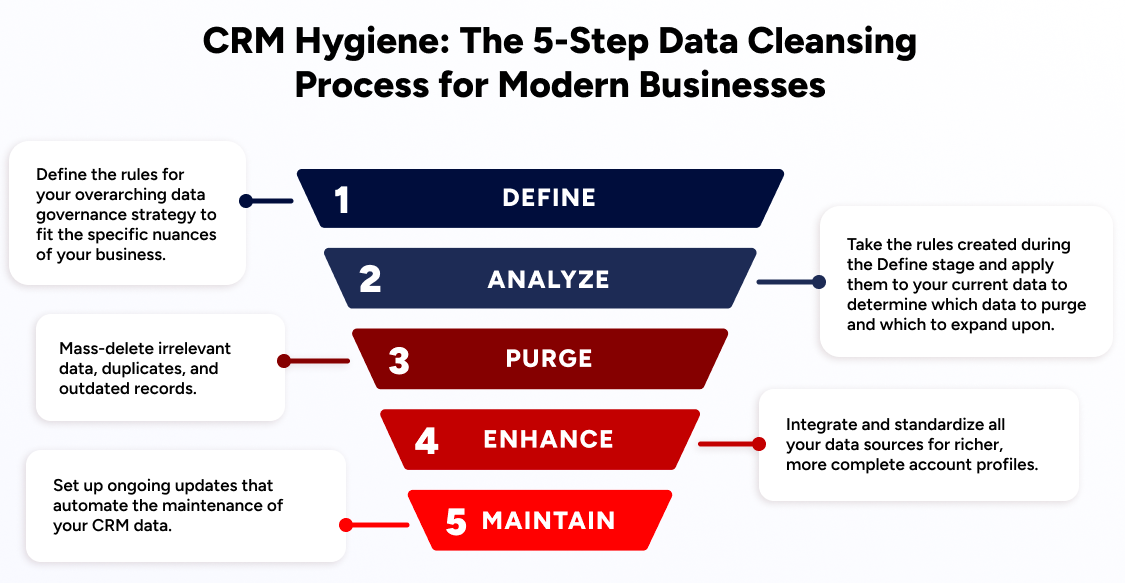The final, critical step in the CRM data hygiene process is all about maintenance. Teams don’t only need clean data — they also need a way to make sure their CRM doesn’t backslide into chaotic, messy data.
This means the updates you set up need to reflect the changing nature of your total addressable market (TAM). For example, if you’re working with hierarchy data, you’ll eventually need to adjust parent and child linkages to reflect mergers and acquisitions as they happen.
The most competitive businesses know the importance of subscribing to robust data services that support your data hygiene maintenance work. Beyond completing the initial cleansing process, you want to make sure your teams continue to work with data that’s accurate and useful whenever and wherever they need it.
The CRM Hygiene Series
This blog is part of a comprehensive series of guides that dive deeper into each of the five steps in the CRM data hygiene process. Navigate to each step to learn more about each step, including how to apply them, why they’re necessary, and the technical aspects of it all below.
A Key Challenge: Building Scalable Data Cleaning Systems That Are Also Flexible
CRM maintenance requires a proactive approach to future data changes. Teams need to find ways to continuously adapt and update processes to keep data accurate as markets change.
Scalable maintenance ensures that teams can continue to make informed decisions, efficiently build out their operations, and maintain a competitive edge.
To maintain optimal CRM hygiene:
1. Apply Steps 2, 3 and 4 in the CRM Hygiene Process on a Regular Basis
For any data-driven company, each client’s data might include hundreds of contacts, with each involved in dozens of annual transactions, preferences, and interactions. Now, factor in the dynamic nature of businesses — mergers, acquisitions, leadership changes, and market shifts — and you’re left with a CRM that can’t keep up if it stands still.
Regularly updating this vast web of business data, at scale, makes sure that your sales rep in New York and your marketer in London are both building their strategies based on the same, real-time information. The goal is a CRM that continues to stay clean for a shared, accurate view of the playing field — with a living, breathing CRM as your core asset.
In the Maintain phase, continue to apply steps two, three, and four on an ongoing schedule:
2. Set up and Maintain Automated Rule-Based Triggers
Setting up and maintaining automated rule-based triggers simplifies CRM maintenance by minimizing any manual data upkeep.
Automated triggers can update contact information when a customer’s job changes or delete duplicates. With the right data management solution, data teams are able to specify conditions for each trigger.
For example, if a contact’s email domain changes (indicating a change in their company), this could trigger an automatic update of the company name, sector, and job title based on the new domain.
However, for that to happen, you’d want to map actions to triggers — assigning specific actions to be taken when each condition is met. In the case of the email domain change, the action might be to search an external database for the new company information and update the contact’s record in your CRM with the most updated information.
3. Review and Adjust Your Strategies Based on Performance
Finally, keep an eye on your CRM data and continue to refine your automated workflows as your company evolves. If you just set it and forget it, you miss out on the chance to make your CRM smarter and more aligned with the growth of your company.
The End-to-End CRM Hygiene Process That Helps Teams Win Faster
This guide equips data professionals with the play-by-play system that top go-to-market teams use to keep their CRM data not just clean, but accurate and valuable.
Carrying out regular updates, automating routine maintenance, and continually refining your approach based on real-world feedback ensures your CRM stays in perfect sync with your business goals.
It’s why the future of competitive go-to-market motions is a living, breathing CRM.
Speak to a specialist now to learn how to make a clean CRM a reality for your business.


